Reading an “Again, again!” book in a new way
Happy Almost-the-End-of-2020! I think this year has been most challenging for those living with or working with small children. How do you keep them enticed if you can’t get new books from the library or from school? How do you keep yourself from going nuts if you’re tired of rereading the same books? Here’s how.
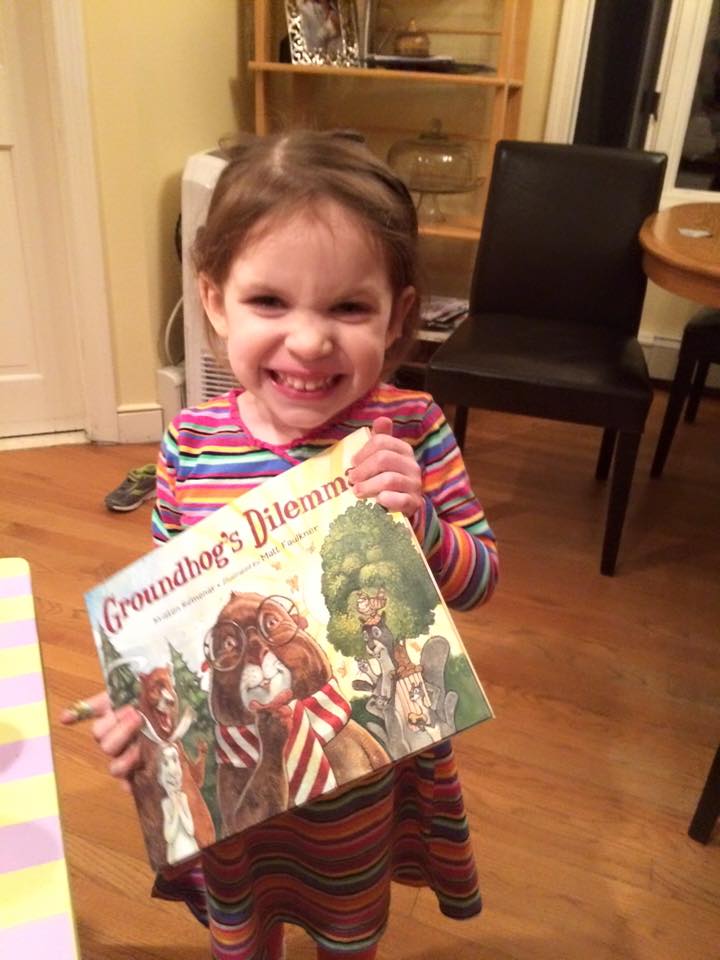
Ask your child, “What do you notice when you look at the cover of this book?” It’s really interesting to hear the details kids notice that we adults may not, the details the illustrator intentionally puts in.
“I see faces in the trees!”
“I see them now, too! Do you notice anything else?”
“The trees have snow on this side and the tree over here doesn’t have snow. So that’s winter and that’s not winter.”
“I wonder why the illustrator drew the trees that way. “
You can talk about what you see until your child is done reading the picture and wants to hear the words. The pictures often give information that the words don’t. Reading pictures is a big part of learning to read words.
This technique of letting kids lead the reading was a big shift for me as a teacher/librarian. I’m eager to get to the words. I’ve often told kids what I want them to learn from the book, trying to pour in knowledge. Lifelong learners are gatherers of knowledge. We can put kids in charge of pulling in meaning first.
Even if it’s a book you’ve read a dozen times, encourage your child to take the lead. They can tell you what they see and show you how their minds are making meaning. You may see the familiar book in a new way when your child says, “Again, again!”
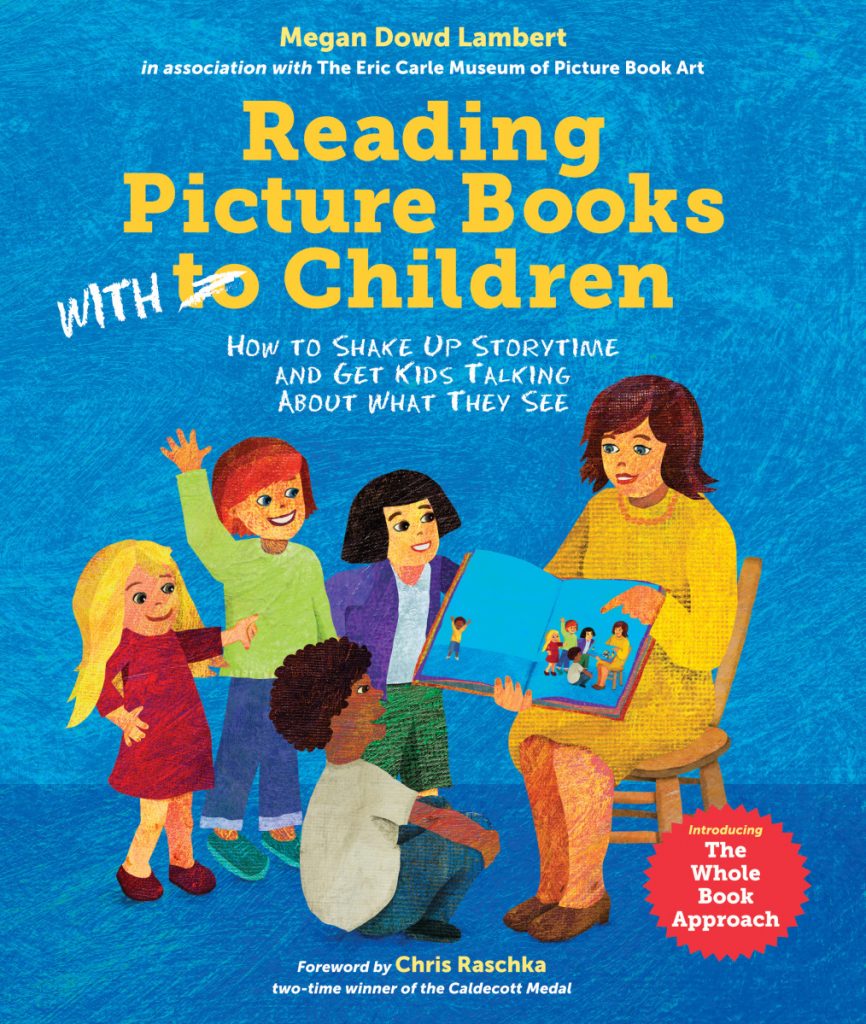
This Whole Book Approach is wonderfully taught by Megan Dowd Lambert in her book, “Reading Picture Books With Children: How to Shake Up Storytime and Get Kids Talking About What They See”. I highly recommend it!
Read MoreWHAT THE FUN?! in July and All Year ‘Round
Sing it with me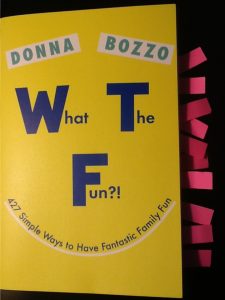 !
!
“What the world
Needs now
Is Fun!
WHAT THE FUN?!”
I picked something fun for July’s professional development book: WHAT THE FUN?! 427 Simple Ways to Have Fantastic Family Fun by Donna Bozzo. As you can see from my pink sticky tabs, I found lots of quick, easy, inexpensive ideas in WHAT THE FUN?! that work well in classrooms as well as at home, like:
- p. 35 “Comedy Club…Let the kids spend the day finding jokes and writing their own material.” Riddle and joke books can be less intimidating for some kids and make for meaningful reading and writing. Anthony, a wiggly first grader, found motivation for self-control when he knew that he could have time to shine as class clown at the end of the day. If everyone quickly got ready for home, the last few minutes before dismissal could be “open mic” time. I could remind Anthony when he got squirrelly during lessons to save it for when we could all enjoy it, a positive consequence instead of a negative one.
- p. 65 “Practice Speaking in a Kind Way and Teach Your Children to Do the Same:…say six nice things to six someones and make their day.” This can be a transition activity, a “brain break”, something to do while waiting in line, etc. Choose kids to compliment and to give compliments randomly (my students all had a class number so I’d just pull from a jar of numbered wooden sticks) or select someone and catch them being good. Some days it’s tough to remember to model kindness, so consider making this a daily or weekly routine.
- p. 149 “Groundhog Day Fun!” Donna Bozzo has
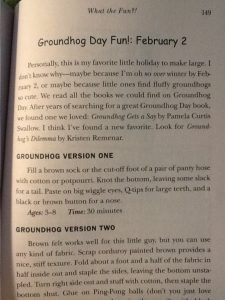 creative ways to share picture books with kids, and she came up with fantastic ideas to use with my book, GROUNDHOG’S DILEMMA! Donna, you made me swoon! I’m going to try both your suggestions for making a groundhog for retelling my story, and your cake with fun-sized candy bars decorated to look like groundhogs peeking up is yummy year ’round.
creative ways to share picture books with kids, and she came up with fantastic ideas to use with my book, GROUNDHOG’S DILEMMA! Donna, you made me swoon! I’m going to try both your suggestions for making a groundhog for retelling my story, and your cake with fun-sized candy bars decorated to look like groundhogs peeking up is yummy year ’round.
Here’s to us all having lots more fun! Thanks, Donna Bozzo!
Read MoreSeptember Bonus List of Books and Activities!
Because I gave a presentation to awesome librarians this month and I couldn’t resist sharing all the great ideas we came up with, you get a bonus post this month! And because you’re getting a bonus post, I hope you’ll allow me to indulge in a bit of horn-tooting.
My debut picture book, GROUNDHOG’S DILEMMA, illustrated by Matt Faulkner (swoon!) will be published by Charlesbridge this December 1st, and it recently received a good professional review:
“Faulkner’s anthropomorphic animals and vibrant colors recall Uncle Wiggly, and the illustrations are packed with humorous details that repay rereadings. Remenar’s graceful prose and the subtlety of her message, pitched to older preschoolers and early-elementary students, are a good match. A sly and funny take on truth-telling and friendship.” – Kirkus, Oct. 2015
Woohoo!!!!!!!
Ok, horn-tooting over.
I spent a morning with a roomful of youth librarians and bunches of new books. We came up with these activities revolving around the key early literacy skills: Talk, Sing, Read, Write, Play. (Look here for lots more good stuff from Every Child Ready to Read.) Many of our activities can be used with a variety of books. I’m including our list of ideas and the books we shared. Enjoy!
TALK:
* Read Rufus Goes to School by Kim T. Griswell and talk about what you need for school, what you shouldn’t do in school, and favorite books you know how to read.
* Read Groundhog’s Dilemma by Kristen Remenar and talk about your favorite/least favorite parts of winter and spring. Talk about animals that hibernate and those that don’t. Talk about why the characters in the story wanted or didn’t want Groundhog to see his shadow.
* Read Clothesline Clues to Sports People Play by Andy Robert Davies and encourage kids to guess the sport. Discuss unfamiliar terms like foil and quiver.
* Use nonfiction books with photos of bees to go along with Bee Dance by Rick Chrustowski. Bring in a honeycomb and give kids bendy straws so they can act like the bees in the book.
* Read Pepper and Poe by Frann Preston-Gannon and discuss why Pepper feels the way he does.
* Discuss good and bad manners after reading The Entertainer by Emma Dodd.
* Encourage kids to respond to “which would you choose?” while reading Hot Rod Hamster by Cynthia Lord.
SING:
* Sing rhyming words, even nonsense ones, after reading Hi! by Ethan Long.
* Sing “Milkshake” after reading Lulu’s Party by Kit Chase.
* Sing the book Old Mikamba Had a Farm by Rachel Isadora.
* Sing “The Days of the Week” song after reading Pepper and Poe by Frann Preston-Gannon, or “If You’re Happy and You Know It”.
* Sing “Take Me Out to the Ball Game” after reading Groundhog’s Dilemma by Kristen Remenar.
READ:
* Read nonfiction books about groundhogs and Groundhog’s Day along with Groundhog’s Dilemma by Kristen Remenar. (It delights me every time I type it!) Use puppets to help narrate/read the story.
* Use magnetic or felt letters to rearrange and read aloud, after reading Little Bird’s Bad Word by Jacob Grant.
WRITE:
* Kids can decorate the first letter of their name or make pictures with die-cut letters after reading Alphabeasties by Sharon Werner and Sarah Forss.
* Write your own “wumbers” inspired by Wumbers by Amy Krouse Rosenthal and Tom Lichtenheld.
* Draw or write about something you cherish after reading Thankful by Eileen Spinelli.
* Trace your shoes and decorate the tracings after reading Whose Shoe? by Eve Bunting.
* Write a letter or draw a picture to convince Groundhog to predict winter or spring after reading Groundhog’s Dilemma by Kristen Remenar. Kids can write and draw about a time when they’ve had to resolve a dilemma. Outside with chalk, or inside on paper, kids can trace their own shadows!
* Create maps of your playground, classroom, school, library, etc. after reading Henry’s Map by David Elliot.
* Paint Q-tip paintings of trees inspired by Fall is Not Easy by Marty Kelley.
* Write your own “word equations” inspired by This Plus That by Amy Krouse Rosenthal.
PLAY:
* Use a string and pin it to a world map to show all the places from Because Amelia Smiled by David Ezra Stein. Compare it to Madlenka and Nothing Ever Happens on My Block.
* Act out Uh Oh! by Shutta Crum.
* Play a version of “Going On a Bear Hunt” after reading In the Canyon by Liz Garton Scanlon.
* Incorporate different dances like The Hokey Pokey and The Twist and act out The Sky Is Falling by Mark Teague. Have a dance party!
* Create hand/body motions and make the sound effects for Niňo Wrestles the World by Yuyi Morales. Come up with other characters who might want to wrestle!
* Move like cats and act out the emotions from Pepper and Poe by Frann Preston-Gannon.
* Have a storytime party where kids act out what should and should not happen at a party after reading The Entertainer by Emma Dodd.
* Paint small boxes like houses after reading Vincent Paints His House by Tedd Arnold.
* Rearrange letter tiles to show how one word can become another after reading One Boy by Laura Vaccaro Seeger.
* Act out Groundhog’s Dilemma by Kristen Remenar. (Still fun to type!) Little ones can curl up in a box and pop out for Groundhog’s Day to look for their shadows, or try making shadow animals on a wall.
Nerd Camp and Twitter
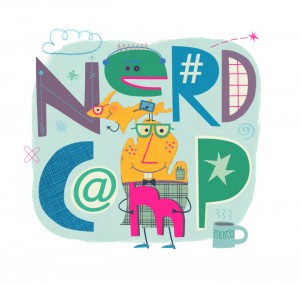 Yesterday I attended nErD Camp, a free, education “unconference” presented by the Nerdy Book Club. For a day and a half, teachers from all over the states came to Parma, Michigan to share ideas about literacy and learning. I led a small session about using public libraries to get kids and teachers the materials they need year-round. I joined sessions on using graphic novels and picture books at all levels and on using Google Docs with forms and add-ins to organize kids’ writing and promote collaboration. (Email me if you want details.)
Yesterday I attended nErD Camp, a free, education “unconference” presented by the Nerdy Book Club. For a day and a half, teachers from all over the states came to Parma, Michigan to share ideas about literacy and learning. I led a small session about using public libraries to get kids and teachers the materials they need year-round. I joined sessions on using graphic novels and picture books at all levels and on using Google Docs with forms and add-ins to organize kids’ writing and promote collaboration. (Email me if you want details.)
Nerd Camp, Jr. was in the evening. Hundreds of kids got to meet authors and illustrators, talk about reading and writing, and score free books. Matt Faulkner, Ruth McNally Barshaw, Linda Urban, Laurie Keller, and others wowed the crowd. (Laurie Keller designed the Nerd Camp logo. Isn’t it fantastic?)
My brain is spinning with new ideas and my appreciation for teachers is even greater than it was before. In July, when most teachers are finally able to enjoy a break, these folks came for a professional development event and generously shared what they knew. I am inspired by you all. Thanks to Colby and Alainna Sharp, Donalyn Miller, Kristin McIlhagga, and the entire Nerdy Book Club powerhouse. nErD Camp 2015 is already in the works if you want in on the fun.
And thank you, Nerds, for pulling me into the world of Twitter! You can follow me @RemenarReads. I promise to tweet only about literacy and books (saving my crazy cat photos for Facebook).
Read More






